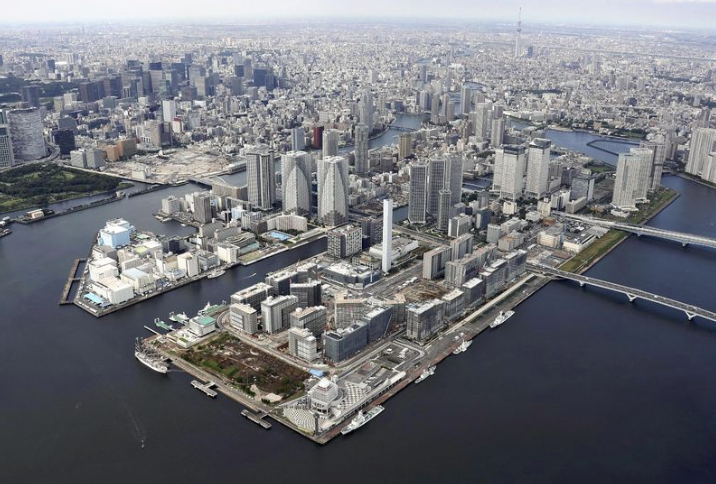
This aerial photo shows work progressing on the Olympic Village on July 19. The Japan News/Asia News Network
TOKYO — The previous Tokyo Olympics, held in 1964, helped accelerate Japan’s economic growth. Fifty-six years later, Tokyo’s second opportunity to host the Summer Games is also spurring activity in various fields, such as improving infrastructure, developing new technologies and introducing new systems, all with an eye not only on the days during the event, but in the years after.
Japan will be renewed through a number of projects. What will the nation look like?
Development for legacy
The Harumi area in Chuo Ward, Tokyo, was once undeveloped land simply called “Tsukishima Number 4.” It was a section of land reclaimed from Tokyo Bay using earth and sand dredged from the mouth of the Sumidagawa river at the beginning of the Showa era (1926-1989).
In 1935, the area had a population of only 16 in five households, but today around 14,500 people reside there. During the Tokyo Olympic and Paralympic Games, the Olympic Village located there will be home to more than 10,000 athletes from around the world.
Before World War II, there were plans to hold a world exposition on this vast stretch of land. There was also talk of moving the Tokyo government building there from its location at the time. But both plans were abandoned. Instead, it served for a transport base by the Imperial Army and Navy, and later was seized as use as an airfield by the Occupation Forces after the war.
In 1958, the Harumi Apartment Housing project with 168 apartments was completed there. The 10-story reinforced concrete building featured the first elevator ever installed by the Japan Housing Corporation, and became a model of high-rise housing.
Takako Nakazawa, 79, moved in at the start of her marriage in 1970 and lived on the building’s top floor until it was rebuilt in 1997. She could see Tokyo Tower and the distant Mt. Fuji from her home.
At the previous Olympics in 1964, her heart began to dance as she saw the five rings drawn in the sky above the National Stadium by the Blue Impulse, the Air Self-Defense Force’s aerobatics team, she said.
“I felt and experienced the changing of the city and society becoming wealthier. I hope there are also benefits for today’s younger people, who will shoulder the next era,” Nakazawa said.
As the walls surrounding construction sites are gradually removed, the public is finally getting a glimpse of the new sports facilities.
“The future of Tokyo and of Japan as a whole will be dependent on the success or failure of the waterfront improvement,” said Takayuki Kishii, adjunct professor in urban engineering at Nihon University. Kishii said a city can become attractive if it makes good use of its waterfront.
After the Games, the Olympic Village will be turned into condominiums. In Harumi, hydrogen will be used as an energy source to generate electricity, and as fuel for buses and cars. It will be the legacy of the Olympic Games to create an environmentally advanced city.